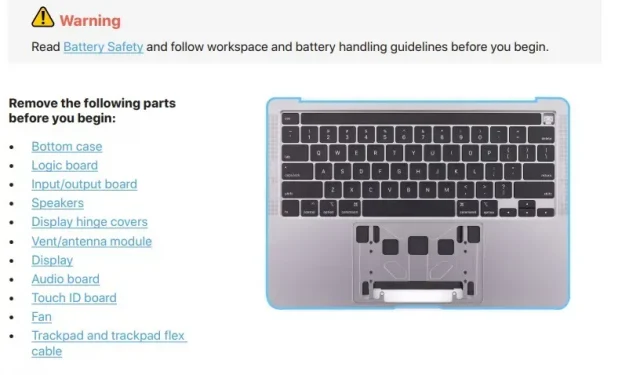MacBook Self-Repair Program Highlights Apple’s Imperfect Progress on Repairability

On Tuesday, Apple expanded its self-service program to M1-based MacBooks. Providing customers with repair guides and the ability to buy parts and buy or rent tools for the M1 MacBook Air and M1 MacBook Pro is a far cry from the Apple of yesteryear. But after a few days of availability, the MacBook self-repair program is showing welcome progress, but work is required before Apple is considered a true repair-eligible ally.
Over the past few days, numerous right-to-repair activists have criticized Apple’s MacBook self-repair program. Perhaps most notable is iFixit’s bluntly worded blog that says the program “makes MacBooks less repairable.”While iFixit found the MacBook Air repair manual “detailed, mostly logical, and deserving of an extra point for repairability”, it was less impressed with the MacBook Pro repair manual.
iFixit focused on Apple’s approach to replacing MacBook Pro batteries, citing the natural degradation of lithium batteries. Apple’s 2021 13-, 14-, and 16-inch MacBook Pro DIY repair guides say that much more than just the battery needs to be removed to replace the battery. The manuals tell users to remove the entire top case, bottom case, battery control box, flex cable, lid angle sensor, trackpad and its flex cable, fan/antenna module, motherboard, display hinge covers, display, laptop audio board, fans, MagSafe 3 card, USB-C cards, and Touch ID card.
This requires you to read most of the 160+ page manual, which warns that “the battery is part of the upper case”and that you should not try to separate them from each other. The manuals also note that the top case includes the BMU board, keyboard, keyboard flex cable, microphone, and speakers, which are “non-removable”.
Essentially, disassembling and reassembling a laptop to replace a battery that is known to need replacing over time is user inconvenient or… typical. iFixit, for example, has a 2021 MacBook Pro 14-inch battery replacement guide that breaks down the process into 26 steps and removes mostly just the bottom case, trackpad, and battery board.
And a quick look at repair guides for other PCs, such as the Lenovo ThinkPad X1 Carbon [ PDF ] or HP Zbook Fury G8, has easier and shorter battery replacement processes. Although this design is different from Apple’s MacBook Pro.
To replace the battery on an M1 MacBook Pro at an Apple self-service store, you’ll also have to buy the entire top case, which will set you back around $527-615 minus an $88 credit if you ship back your original part (you can see a deeper see the price breakdown in this handy price list from The Verge). That’s a high price to pay for a new battery, especially if everything else works.
Apple says it will eventually sell individual batteries to replace the MacBook Pro M1, but didn’t specify when. Until then, a battery replacement done at the Apple Self Repair Store is very time consuming and costly.
“… Apple presents do-it-yourselfers with a torturous series of obstacles: read 162 pages of documentation without fear and decide to fix it anyway, pay an exorbitant amount of money for an excess spare part, decide whether you want to discard it. $50 more for the tools they recommend and do the repair yourself within 14 days including completing the system configuration to pair your part with your device. Which makes us wonder if Apple wants better maintainability at all?”wrote iFixit content consultant Sam Goldhart.
The iFixit blog notes that Apple is not the only company to combine self-service battery replacement with other types of repairs. An example is the screen and battery replacement kit for the Samsung Galaxy S21. But Apple’s breach, iFixit argues, is even worse.
“An Apple requiring a keyboard and top case replacement is worse than a Samsung OEM display assembly because it makes the repair much more difficult by requiring you to take apart the entire device to replace the battery,” Elizabeth Chamberlain, director of sustainability at iFixit, told Ars. She noted that while the assembly of the S21’s battery and display is “also unfortunate,”it makes it easier to change the battery.
The iFixit blog also lamented the mysterious disappearance of the 21.5-inch and 27-inch iMac repair manuals that Apple published in 2019. But there is hope that the guides may return at some point (perhaps with amendments) as Apple continues to expand its self-service repair program.
A less expensive problem is replacing the MacBook Air’s M1 keyboard range. Its replacement costs the same amount of money, $39, as replacing keycaps on a keyboard. As noted by The Verge, Apple, in a move that seems painfully wasteful in many ways, will be selling seven sets of function row keycaps to users at that price.
At the whim of Apple
Since Apple is responsible for its self-service efforts, there are concerns that the Apple Store will eventually make parts unavailable, limiting future self-repairs.
“They will likely phase out product components before the hardware is real (our office is full of 2012 MacBook Pros, for example),” Chamberlain told Ars.
There have been notable changes in the right-to-repair law recently, including the first right-to-repair law in New York City. iFixit argued that further legislation is still needed despite Apple becoming more willing to self-repair. Because just as easily as Apple decided to better accommodate self-repair, it could change its mind.
“When we bow to the whims of manufacturers, we get repairs on their terms,” Chamberlain said. “Apple may remove support and repair guides for product parts at any time – evidence of this is the fact that they have removed guides for the 2019 iMac.”
Leave a Reply